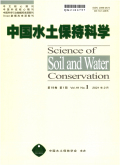中国水土保持科学2024,Vol.22Issue(3):12-19,8.DOI:10.16843/j.sswc.2022001
泥石流停淤工程应用现状与思考
Application situation and considerations of debris flow deposition works
摘要
Abstract
[Background]The comprehensive prevention system of debris flow mainly consists of the stabilization,blockage,drainage,and deposition works.Among them,deposition work plays an important role in debris flow mitigation and thus is widely used in many engineering applications.Despite its importance,systematic research on deposition work,however,is still rare.As a result,the design of debris flow deposition projects mostly relies on the personal empirical experiences of engineers currently,regardless of the law of equilibrium deposition.[Methods]After summarizing and analyzing numerous relevant domestic and international literature,several methods regarding field investigation of the existing deposition works of debris flow,including remote sensing imagery interpretation,topographic survey,and engineering structure parameters analysis,were carried out.This is aimed at the problems concerning the diversion,equilibrium deposition,and energy dissipation measure of existing deposition works of debris flow.[Results]The debris flow storage basin became popular and has been applied in numerous engineering applications after the Wenchuan earthquake and Jiuzhaigou earthquake.The suitable conditions for debris flow storage basins include:1)The spatial condition for the debris flow drainage channel is lacking due to the insufficient deposition space;2)many debris flow gullies,e.g.,the Jiuzhaigou gully,didn't have the spatial condition of drainage because of the steep longitudinal gradient of gully bed;3)many linear projects(i.e.,highways and railways)pass through the middle of the debris flow fan,which makes the drainage measures of debris flow invalid.Although deposition works compensated for the measures of debris flow mitigation,some shortcomings arise and are summarized as follows:1)The space of debris flow deposition works is not rationally utilized due to the absence of diversion and equilibrium deposition measures;2)the design of deposition works still largely depends on personal empirical experiences;in particular,the calculation of deposition volume is obtained by estimation,which,of course,results in large errors;3)great damage to the retaining wall occurs because there are no energy dissipation measures in the storage basin;4)the design of traditional debris flow retaining wall does not consider the impact force of debris flow;5)apparent contradiction between the area occupied by deposition works and the human land use arise.[Conclusions]Given the shortcoming mentioned above,the equilibrium deposition law of deposition works of debris flow is put forward,as well as some optimization methods concerning volumetric capacity configuration,structural style,and design parameters of retaining wall.The results obtained in this study could contribute to the early design and research of the deposition works of debris flow.关键词
泥石流/防治工程/停淤场/应用现状/均衡停淤Key words
debris flow/mitigation engineering/storage basin/application situation/equilibrium deposi-tion分类
地质学引用本文复制引用
赵万玉,游勇,陈晓清,杨东旭..泥石流停淤工程应用现状与思考[J].中国水土保持科学,2024,22(3):12-19,8.基金项目
国家自然科学基金"约束条件下泥石流停淤特征与均衡停淤方法研究"(51709259) (51709259)
国家重点研发计划课题"村寨地质灾害智能监测与治理技术研发及应用示范"(2020YFD1100701) (2020YFD1100701)

